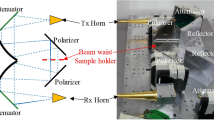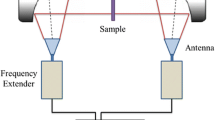Abstract
This paper describes effects of electrical properties of materials to recognize the liquids with high accuracy. The goal of this study is to quickly characterize a liquid by making accurate predictions. By interpreting the relationships between the specified properties, the forecasts have been tried to be executed about other important parameters of any liquid. However, although the effects of the important parameters are paid attention, the temperature effect is not considered, in this study. Considering the high importance of safety and security applications, the liquids analyzed in this study were chosen to be transported by one person on various trips. Two different microwave spectroscopy systems (reflectivity free space and coaxial probe measurement methods), are used to collect the electrical properties of liquids by vector network analyzer. Furthermore, these specially selected liquids are first measured in a wide frequency range and the values of their complex permittivity are given.








Similar content being viewed by others
Change history
19 March 2020
Unfortunately, the author had missed to include the below acknowledgement text in the original publication of the article.
References
Al-Mously, S.I.Y.: A modified complex permittivity measurement technique at microwave frequency. Int. J. New Comput. Archit. Appl. 2, 389–401 (2012)
Buyukozturk, O., Yu, T.Y., Ortega, J.A.: A methodology for determining complex permittivity of construction materials based on transmission-only coherent, wide-bandwidth free-space measurements. Cem. Concr. Compos. 28, 349–359 (2006). https://doi.org/10.1016/j.cemconcomp.2006.02.004
Haddadi, K., Wang, M.M., Benzaim, O., Glay, D., Lasri, T.: Contactless microwave technique based on a spread-loss model for dielectric materials characterization. IEEE Microw. Wirel. Compon. Lett. 19, 33–35 (2009). https://doi.org/10.1109/LMWC.2008.2008573
Jilani, M.T., Zaka, M., Khan, A.M., Khan, M.T., Ali, S.M.: A brief review of measuring techniques for characterization of dielectric materials. Int. J. Inf. Technol. Electr. Eng. 1, 1–5 (2012)
Tereshchenko, O.V., Buesink, F.J.K., Leferink, F.B.J.: An overview of the techniques for measuring the dielectric properties of materials. In: XXXth URSI General Assembly and Scientific Symposium. pp. 1–4. IEEE (2011)
Tosaka, T., Fujii, K., Fukunaga, K., Kasamatsu, A.: Development of complex relative permittivity measurement system based on free-space in 220-330-GHz range. IEEE Trans. Terahertz Sci. Technol. 5, 1–8 (2014). https://doi.org/10.1109/TTHZ.2014.2362013
Górny, M., Rzoska, S.J.: Experimental solutions for nonlinear dielectric studies in complex liquids. In: Rzoska, S.J., Zhelezny, V. (eds.) Nonlinear Dielectric Phenomena in Complex Liquids, 1st edn., pp. 45–53. Kluwer Academic Publishers, Dordrecht (2004)
Kraut, H., Eiblmaier, J., Grethe, G., Löw, P., Matuszczyk, H., Saller, H.: Algorithm for reaction classification. J. Chem. Inf. Model. 53, 2884–2895 (2013). https://doi.org/10.1021/ci400442f
Orzechowski, K., Kosmowska, M.: Dielectric properties of critical conducting mixtures. In: Rzoska, S.J., Zhelezny, V. (eds.) Nonlinear Dielectric Phenomena in Complex Liquids, 1st edn., pp. 89–100. Kluwer Academic Publishers, Dordrecht (2004)
Urban, S., Wűrflinger, A.: Influence of pressure on the dielectric properties of liquid crystals. In: Rzoska, S.J., Zhelezny, V. (eds.) Nonlinear Dielectric Phenomena in Complex Liquids, 1st edn., pp. 211–220. Kluwer Academic Publishers, Dordrecht (2004)
Liu, L.: Application of microwave for remote NDT and distinction of biofouling and wall thinning defects ınside a metal pipe. J. Nondestruct. Eval. 34, 40 (2015). https://doi.org/10.1007/s10921-015-0313-9
Eremenko, Z.E., Skresanov, V.N., Shubnyi, A.I., Anikina, N.S., Gerzhikova, V.G., Zhilyakov, T.A.: Complex permittivity measurement of high loss liquids and its application to wine analysis. In: Zhurbenko, V. (ed.) Electromagnetic Waves, 1st edn., pp. 403–422. InTech, Rijeka (2011)
Jiang, Y., Ju, Y., Yang, L.: Nondestructive ın-situ permittivity measurement of liquid within a bottle using an open-ended microwave waveguide. J. Nondestruct. Eval. 35, 7 (2016). https://doi.org/10.1007/s10921-015-0322-8
Li, Z., Haigh, A., Soutis, C., Gibson, A., Sloan, R.: A simulation-assisted non-destructive approach for permittivity measurement using an open-ended microwave waveguide. J. Nondestruct. Eval. 37, 39 (2018). https://doi.org/10.1007/s10921-018-0493-1
Pappas, R.A., Bamberger, J.A., Bond, L.J., Greenwood, M.S., Panetta, P.D., Pfund, D.M.: Ultrasonic methods for characterization of liquids and slurries. In: 2001 IEEE Ultrasonics Symposium. Proceedings. An International Symposium (Cat. No.01CH37263), pp. 563–566. IEEE (2001)
Cherpak, N.T., Barannik, A.A., Prokopenko, Y.V., Smirnova, T.A., Filipov, Y.F.: A new technique of dielectric characterization of liquids. In: Rzoska, S.J., Zhelezny, V. (eds.) Nonlinear Dielectric Phenomena in Complex Liquids, 1st edn., pp. 63–76. Kluwer Academic Publishers, Dordrecht (2004)
Jiang, X., Yang, T., Li, C., Zhang, R., Zhang, L., Zhao, X., Zhu, H.: Rapid liquid recognition and quality ınspection with graphene test papers. Glob. Chall. 1, 1700037 (2017). https://doi.org/10.1002/gch2.201700037
Ozturk, T.: Classification of measured unsafe liquids using microwave spectroscopy system by multivariate data analysis techniques. J. Hazard. Mater. 363, 309–315 (2019). https://doi.org/10.1016/j.jhazmat.2018.09.092
Kim, S., Kwak, J., Ko, B.: Automatic classification algorithm for raw materials using mean shift clustering and stepwise region merging in color. J. Broadcast. Eng. 21, 425–435 (2016). https://doi.org/10.5909/JBE.2016.21.3.425
Ozturk, T., Elhawil, A., Uluer, İ., Guneser, M.T.: Development of extraction techniques for dielectric constant from free-space measured S-parameters between 50 and 170 GHz. J. Mater. Sci.: Mater. Electron. 28, 11543–11549 (2017). https://doi.org/10.1007/s10854-017-6953-z
Ozturk, T., Hudlička, M., Uluer, İ.: Development of measurement and extraction technique of complex permittivity using transmission parameter S21 for millimeter wave frequencies. J. Infrared Millim. Terahertz Waves 38, 1510–1520 (2017). https://doi.org/10.1007/s10762-017-0421-y
Petersson, L.E.R., Smith, G.S.: An estimate of the error caused by the plane-wave approximation in free-space dielectric measurement systems. IEEE Trans. Antennas Propag. 50, 878–887 (2002). https://doi.org/10.1109/TAP.2002.1017671
Mitani, T., Hasegawa, N., Nakajima, R., Shinohara, N., Nozaki, Y., Chikata, T., Watanabe, T.: Development of a wideband microwave reactor with a coaxial cable structure. Chem. Eng. J. 299, 209–216 (2016). https://doi.org/10.1016/j.cej.2016.04.064
Santos, J.C.A., Dias, M.H.C., Aguiar, A.P., Borges Jr., I., Borges, L.E.P.: Using the coaxial probe method for permittivity measurements of liquids at high temperatures. J. Microw. Optoelectron. Electromagn. Appl. 8, 78–91 (2009)
Zajíček, R., Oppl, L., Vrba, J.: Broadband measurement of complex permitivity using reflection method and coaxial probes. Radioengineering 17, 14–19 (2008)
Lange, N.A., Dean, J.A.: Lange’s handbook of chemistry. J. Pharm. Sci. 68, 805–806 (1979). https://doi.org/10.1002/jps.2600680645
Grünewald, H.: CRC handbook of chemistry and physics. Angew. Chemie. 78, 912 (1966). https://doi.org/10.1002/ange.19660781827
Lucic, B., Basic, I., Nadramija, D., Milicevic, A., Trinajstic, N., Suzuki, T., Petrukhin, R., Karelson, M., Katritzky, A.R.: Correlation of liquid viscosity with molecular structure for organic compounds using different variable selection methods. Arkivoc 2002, 45 (2002). https://doi.org/10.3998/ark.5550190.0003.406
Yao, M., Endo, H.: Structure and physical properties of liquid chalcogens. J. Non. Cryst. Solids. 205–207, 85–88 (1996). https://doi.org/10.1016/S0022-3093(96)00216-5
Pohanish, R.P.: Sittig’s Handbook of Toxic and Hazardous Chemicals and Carcinogens. Elsevier, Amsterdam (2012)
Zhang, H.: Electrical properties of food. Food Eng. 1, 1–5 (2009)
Kumar, D., Singh, A., Tarsikka, P.S.: Interrelationship between viscosity and electrical properties for edible oils. J. Food Sci. Technol. 50, 549–554 (2013). https://doi.org/10.1007/s13197-011-0346-8
Zhang, G.-H., Yan, B.-J., Chou, K.-C., Li, F.-S.: Relation between viscosity and electrical conductivity of silicate melts. Metall. Mater. Trans. B 42B, 261–264 (2011). https://doi.org/10.1007/s11663-011-9484-7
Zhang, G.-H., Chou, K.-C.: Correlation between viscosity and electrical conductivity of aluminosilicate melts. Metall. Mater. Trans. B 43B, 849–855 (2012). https://doi.org/10.1007/s11663-012-9674-y
Author information
Authors and Affiliations
Corresponding author
Rights and permissions
About this article
Cite this article
Ozturk, T. Characterization of Liquids Using Electrical Properties in Microwave and Millimeter Wave Frequency Bands. J Nondestruct Eval 38, 11 (2019). https://doi.org/10.1007/s10921-018-0553-6
Received:
Accepted:
Published:
DOI: https://doi.org/10.1007/s10921-018-0553-6




